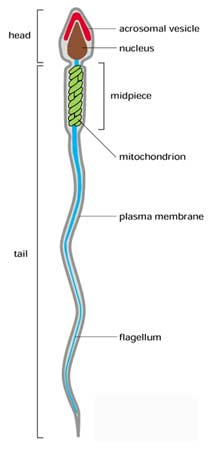 |
Seminal Fluid is slightly alkaline (pH 7.2-7.4). Prior to ejaculation, 1-2 drops of a clear, colorless liquid secreted by the bulbourethral glands neutralizes the acidity of the urethra. Next follows the milky prostate secretion, usually free of spermatozoa, and then the part with the spermatozoa. Finally, appears the gelatinous, highly viscous secretion of the seminal vesicles. Fructose originates mainly from the seminal vesicles, and appears to be important as a source of energy for the motility of the spermatozoa in the anaerobic environment of the female reproductive tract (oxygen is toxic to sperm).
Fertility: A normal volume of semen appears to be important to buffer the acidity of the vaginal secretions. Motility of the spermatozoa is dependent on the pH value, and in contact with the acid vaginal secretion (pH 3.5-4.2), they are rapidly immobilized. Too large a volume of semen dilutes the spermatozoa and, moreover, semen may escape from the vagina. A concentration of 60 million spermatozoa per milliliter is usually considered the lower limit for a fertile semen.
The semen coagulates immediately after ejaculation and then liquifies under the influence of proteolytic enzymes, primarily from the prostate, and results in a relatively high concentration of free amino acids. The female orgasm rapidly draws any material deposited at the uterus into the upper neck of the cervix, facilitating the migration of the sperm toward the egg and removing them from the hostile environment of the vagina. Needless to say, female orgasm may not always occur immediately subsequent to male ejaculation and neither is coitus always timed to coincide with ovulation. Therefore, sperm motility and longevity are adaptations that can achieve fertilization when timing is not perfect.
Environmental Factors: There have been recent reports that the sperm count has been declining around the world. It has been suggested that estrogen analogs released into the environment, e.g., herbicides, that act similarly to estrogens, can enter the water supply and diminish the quantity and quality of the sperm. In addition, smoking, alcohol, heat, and some drugs can damage sperm. Spermatozoal concentration can vary greatly in an individual and is adversely affected by severe emotional stress and physical exertion and can be diminished by prolonged continence which increases the proportion of abnormal spermatozoa. On the other hand, a good nutritional status and good health are beneficial.
Diem, Konrad. 1962. Documenta Geigy Scientific Tables. 6th Edition. Published by Geigy Pharmaceuticals, Ardsley, New York. pp 598-603.
Semen
Healthy Sperm